Making wooden domino blocks
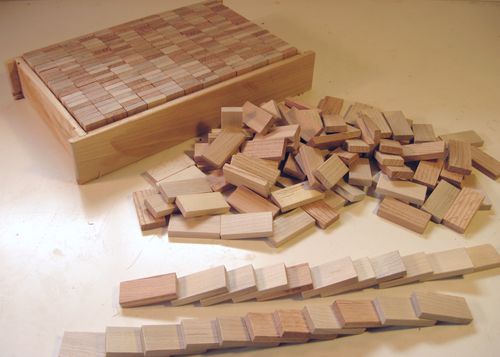 I needed some suitably sized "domino blocks" to test my improved
domino row building machine.
Seeing that I didn't ever intend to play dominoes with these
blocks, I was at liberty to make them any size and shape I wanted to. As it is,
they are a bit shorter than real dominoes, which I think makes them better for
building domino rows.
I needed some suitably sized "domino blocks" to test my improved
domino row building machine.
Seeing that I didn't ever intend to play dominoes with these
blocks, I was at liberty to make them any size and shape I wanted to. As it is,
they are a bit shorter than real dominoes, which I think makes them better for
building domino rows.
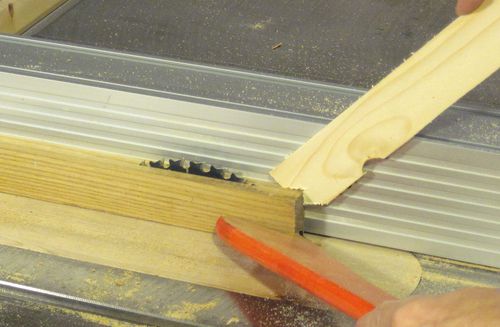 To make my wooden "dominoes", I ripped some wood into sections about
23.5 x 7.5 mm on the table saw. I used a very thin 7 1/4" (185 mm) circular
saw blade to avoid wasting too much wood.
To make my wooden "dominoes", I ripped some wood into sections about
23.5 x 7.5 mm on the table saw. I used a very thin 7 1/4" (185 mm) circular
saw blade to avoid wasting too much wood.
I cut a notch into a thin piece of scrap to use as a narrow push stick behind the blade. I often end up cutting into the push stick doing this sort of thing so its best to make a temporary one.
Also note that I'm using a zero clearance insert on my table saw. That sort of thing is essential when cutting thin strips between the fence and the blade. Otherwise, the cut pieces end up getting sucked into the gap next to the blade.
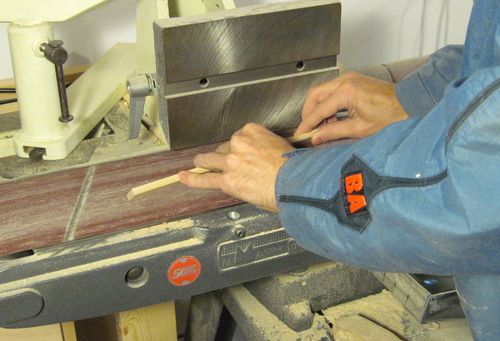 I slightly rounded the long edges of my strips of wood before cutting them to length.
Its less work sanding the long edges on the strips than it is to sand the individual
blocks once they are cut apart.
I slightly rounded the long edges of my strips of wood before cutting them to length.
Its less work sanding the long edges on the strips than it is to sand the individual
blocks once they are cut apart.
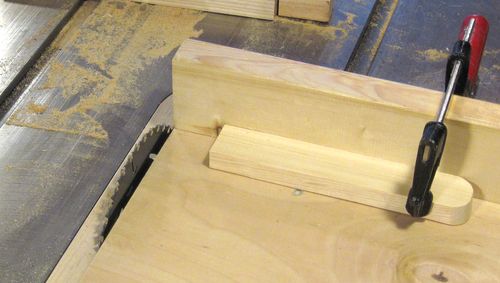 To cut the dominoes to length I clamped a small block of wood to my
table saw sled as a stop. The block of wood is wide
enough to act as a stop for a stack of five dominoes at a time.
To cut the dominoes to length I clamped a small block of wood to my
table saw sled as a stop. The block of wood is wide
enough to act as a stop for a stack of five dominoes at a time.
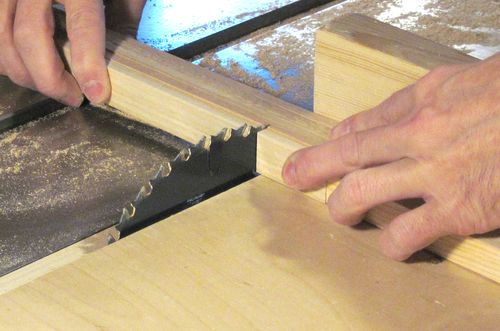 When cutting small pieces of hardwood the table saw blade often starts vibrating
while making a cut. This happens much less with thicker stock, so stacking
up five strips at a time not only saves time but also makes for a cleaner
cut in the effectively larger piece.
Stacking five pieces also means that four of the five
pieces have another piece behind them, so only the last domino suffers from
any tearout at the back.
When cutting small pieces of hardwood the table saw blade often starts vibrating
while making a cut. This happens much less with thicker stock, so stacking
up five strips at a time not only saves time but also makes for a cleaner
cut in the effectively larger piece.
Stacking five pieces also means that four of the five
pieces have another piece behind them, so only the last domino suffers from
any tearout at the back.
Note how close my fingers are to the blade. For cuts like that it's important to position one's hands so that the fingers, even if fully extended, don't reach the blade. That way, if something unpredictable were to happen and the pieces thrown out of my hands somehow, my fingers would still not get caught in the blade.
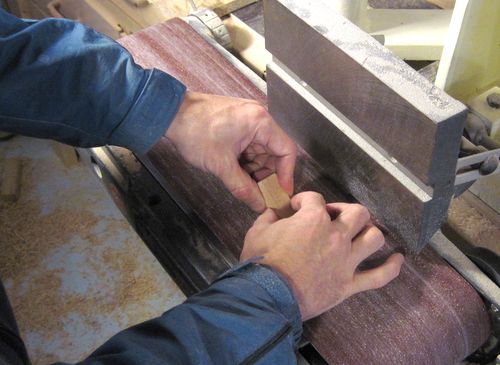 After cutting all the dominoes to length, I round the edges and corners.
I do this on my belt sander. I made over 300 dominoes, so
it helps to figure out the most expedient way to it. I got into a routine
where I could do all the edges on both ends of a domino in about five seconds
per domino. I'm using both hands so I can flip them over faster.
I flipped it while still in contact with the belt so that I'd cover the corners
in the process of flipping it.
After cutting all the dominoes to length, I round the edges and corners.
I do this on my belt sander. I made over 300 dominoes, so
it helps to figure out the most expedient way to it. I got into a routine
where I could do all the edges on both ends of a domino in about five seconds
per domino. I'm using both hands so I can flip them over faster.
I flipped it while still in contact with the belt so that I'd cover the corners
in the process of flipping it.
I don't have to be as careful with a belt sander. In fact, doing stuff like that, I almost always at some point or other end up touching the sanding belt. But it's usually such a quick and light touch when it does happen, that its hard to find the scuffed spot when it does happen.
Back to my Domino row building machine
![]()